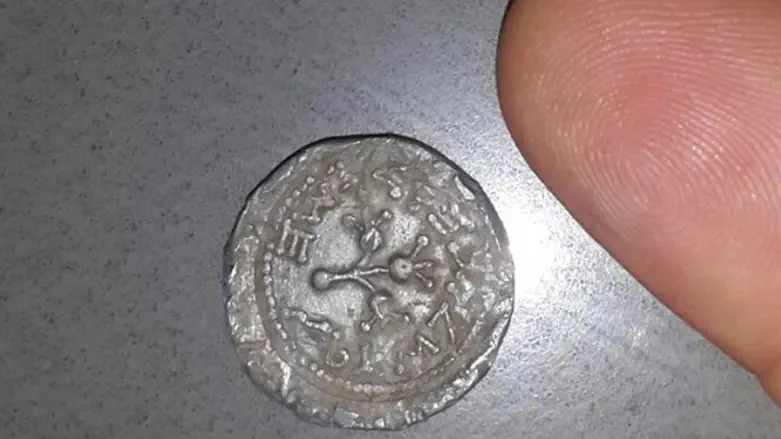
A surprising and apparently shocking discovery in Neve Tzuf, in Binyamin:Hallel, a girl of about nine, discovered an ancient coin that turned out to be a half-shekel coin with the inscription "Holy Jerusalem."
Arutz Sheva spoke with the girl, Hallel, and her father, attorney Shimon Halevy, and Prof. Zohar Amar, who conducted the preliminary examination of the coin.
Of the day his daughter showed him the coin, he says: "The girl curiously approached me with a dark coin and asked me 'Dad, does this seem important to you?' This is a coin with markings like an Israeli shekel, but it does not look like a coin of our time.At first it was hard for me to believe that this was something special, and I told her to give me the coin and I would check."
In order to check the coin, Halevy turned to a resident of the town, Prof. Zohar Amar, an history expert: "I was impressed that he was very interested in asking questions," the father says. "We went to his house and showed him the coin. His wife Tamar also has knowledge of these things.They looked and were very skeptical and then decided that the real test would be to take a very delicate scale and see if the weight fits that of a shekel.Prof. Amar expected it to be 14 grams, which is a shekel.When it was less he was hesitant, but then he said it was half.That's the half-shekel piece."
On his daughter's realization that this was a genuine historical discovery, he says: When he realized that this was a real historical discovery, he said: "The girl understood that she merited a great privilege, I was excited, I showed her the sources that speak of a coin of this kind, and she began to reconstruct where she found the coin next to an archaeological site near the settlement. This is a site about which not much is known. Its history is from the time of the Second Temple."
Later we spoke with the daughter, Hallel, who told us about the trip where she found the coin at the archaeological site near her town, Neve Tzuf-Halamish. Not much is known about the site, she says, except that in the past people lived there.
Hallel noticed the silver coin during the tour, because "I usually like to pick things up from the ground."For a few days she did not think she had a particularly exciting discovery, but it was her sister who encouraged her to show her father.
About her current feelings, now that she knows that the coin will probably not remain in her hands but will be handed over to the state authorities, she feels a bit sad, but also moved in light of the significance of finding a coin from the time of the Temple near the community in which she lives.
We also spoke with Prof. Amar himself, who emphasizes at the outset that "one should be cautious and say that things require further examination," but he says: "When I saw the coin I felt that I was dealing with something I had dealt with in the past - coins from the rebellion and their significance.After 10-15 minutes I realized that it was a half-shekel piece from 66-70 CE. It has a Hebrew imprint that says 'Holy Jerusalem.' The Jews minted such coins against the coins minted in Tyre in order to stress the symbolism and nationalism, and in the Temple they used only these coins because they are a very high quality of silver," he said.
Amar notes that "such coins were found in Israel, but the discovery at Neve Tzuf raises interest because the area was a very large center and according to Josephus, Jews participated during the revolt and there is evidence that supports this report.This is an area where the pilgrims passed through on their way to Jerusalem.The Romans understood that if they wanted to conquer Jerusalem they should first oppress the Jews here on the way to Jerusalem.Also found in the area are communal mikvaot (ritual pools) for those interested in going up to Jerusalem in purity.
"The village of Beit Rima, which appears in Mishnah in Menachot, is located three kilometers away and from there the libations were brought to the Temple.In the area of Neve Tzuf, there is a unique site in the world where a special wine was produced, which in case of great need was permitted to be transferred to the Temple.There is a great deal of data linking the Neve Tzuf area to the subject of the Temple and the coin sheds additional light on this issue."
Of the place where Hallel found the coin, he notes that it is not only a hiking area as it is used by the residents, but rather that "it has become a regional tourist site and from all over the country because of the uniqueness of its winepresses.
"After all that we went through recently, the discovery is very interesting because the Romans wanted to kill us, but we came back here, and this year we will be celebrating the 40th anniversary of the settlement of Neveh Tzuf," says Prof. Amar. "Renewed nectar (tzuf)."